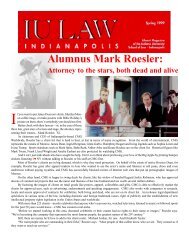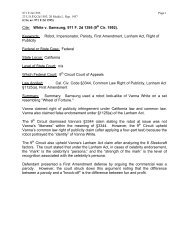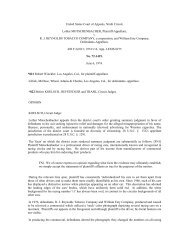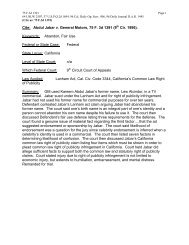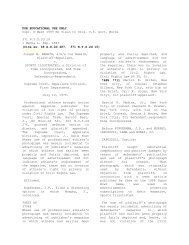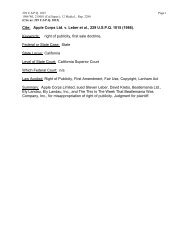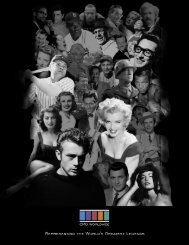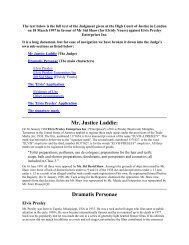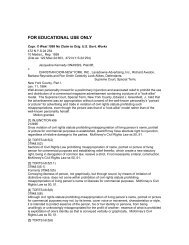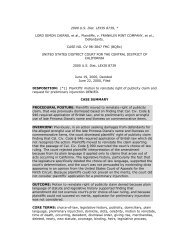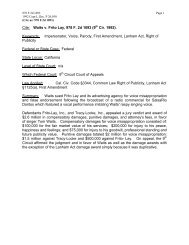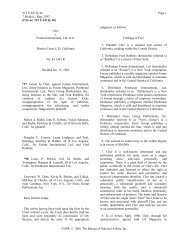Hustler v. Falwell.pdf - Mark Roesler
Hustler v. Falwell.pdf - Mark Roesler
Hustler v. Falwell.pdf - Mark Roesler
You also want an ePaper? Increase the reach of your titles
YUMPU automatically turns print PDFs into web optimized ePapers that Google loves.
8 U.S.P.Q.2D (BNA) 1562; 15 Media L. Rep. 2097<br />
means of motion pictures is included within the free speech and free press<br />
guaranty of the First and Fourteenth Amendments." Id. at 502. The Court<br />
reaffirmed this principle with respect to all works of entertainment in Schad v.<br />
Borough [**11] of Mount Ephraim, 452 U.S. 61, 68 L. Ed. 2d 671, 101 S.<br />
Ct.<br />
2176 (1981):<br />
Entertainment, as well as political and ideological speech, is protected; motion<br />
pictures, programs broadcast by radio and television and live entertainment,<br />
such as musical and dramatic works fall within the First Amendment guarantee.<br />
Schad, 452 U.S. at 65 (citations omitted).<br />
The New York courts, mindful of the importance of the First Amendment's<br />
protect ions and of the potential danger of levying civil sanctions which might<br />
inhibit artistic expression, have carefully guarded against imposing liability<br />
in connection with motion pictures. Thus, in the leading New York case of<br />
University of Notre Dame Du Lac v. Twentieth Century-Fox Corp., 22 A.D.2d<br />
452,<br />
256 N.Y.S.2d 301 (1st Dep't), aff'd, 15 N.Y.2d 940, 259 N.Y.S.2d 832, 207<br />
N.E.2d<br />
508 (1965), the Court stated:<br />
It is at once apparent, when we deal with the content of a book or motion<br />
picture, that we deal with no ordinary subject of commerce. Motion pictures, as<br />
well as books, are "a significant medium for the communication of ideas"; their<br />
importance "as an organ of public opinion is not lessened by the fact that they<br />
are designed to entertain as well as to inform", and like books, they [**12]<br />
are a constitutionally [*117] protected form of expression notwithstanding<br />
that "their production, distribution, and exhibition is a large-scale business<br />
conducted for private profit" (Joseph Burstyn v. Wilson, 343 U.S. 495, [96 L.<br />
Ed. 1098, 72 S. Ct. 777] . . .; Jacobellis v. State of Ohio, 378 U.S. 184, [12<br />
L. Ed. 2d 793, 84 S. Ct. 1676 (1964)] . . .).<br />
Notre Dame, 256 N.Y.S.2d at 306. Accordingly, the courts in New York are<br />
cautious not to construe the First Amendment's scope too narrowly and have<br />
recognized its applicability to all legitimate forms of entertainment. As the<br />
court stated in Paulsen v. Personality Posters, Inc., 59 Misc. 2d 444, 299<br />
N.Y.S.2d 501 (N.Y. Co. 1968):<br />
The scope of the subject matter which may be considered of "public interest" or<br />
"newsworthy" has been defined in most liberal and far reaching terms. The<br />
privilege of enlightening the public is by no means limited to dissemination of<br />
news in the sense of current events but extends far beyond to include all types<br />
of factual, educational and historical data, or even entertainment and<br />
amusement, concerning interesting phases of human activity in general.<br />
Paulsen, 299 N.Y.S.2d at 506. The courts of this Circuit have been equally<br />
vigilant in recognizing the protection [**13] afforded artistic expression.<br />
See, e.g., United States v. A Motion Picture Film Entitled "I Am Curious --<br />
Yellow", 404 F.2d 196, 199 (2d Cir. 1968); Natco Theatres v. Ratner, 463 F.<br />
Supp. at 1128; Man v. Warner Bros. Inc. 317 F. Supp. 50, 52 (S.D.N.Y. 1970);<br />
but



